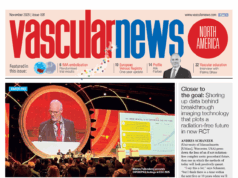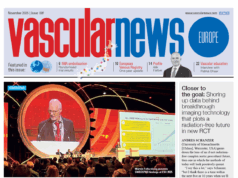
By Gert Jan de Borst
The stroke and operative mortality rates associated with carotid endarterectomy have been thoroughly documented. In contrast, the incidence of injury to the cranial nerves has received relatively little attention.
The reported incidence of injury to cranial nerves following carotid endarterectomy varies from less than 5% to more than 50% depending on whether the study was conducted prospectively or retrospectively, on variation in definition of cranial nerve injury, and on the sensitivity of the investigative method. Some studies included sensory deficits in the distribution of the branches of the cervical plexus, whereas others excluded them. Loss of cervical nerve sensation is always present after carotid endarterectomy but tends to improve with time. However, the timing and extent of this improvement is unpredictable. Patients are usually not disturbed by these changes. When disregarding the frequently injured cutaneous sensory cervical nerves, the nerves at potential risk include VII (facial), IX (glossopharyngeus), X (vagus), XI (accessory), and XII (hypoglossal).
The hypoglossal nerve appears to be most susceptible to injury because of its proximity to the carotid bifurcation, followed by vagal nerve injury. However, routine postoperative laryngoscopy undoubtedly established the diagnosis of recurrent laryngeal nerve dysfunction in several patients whose hoarseness might otherwise have been attributed to recent endotracheal intubation during general anesthesia, and it is assumed that vocal cord paralysis occurs more frequently following endarterectomy than often reported. Although laceration may occur, transaction injuries probably are unusual, while blunt trauma probably is responsible for most cranial nerve injuries during carotid endarterectomy.
Most importantly, in any study reporting on cranial nerve injury related to carotid endarterectomy the rate of permanent lesions seems very low. This has been confirmed by randomised controlled trial data and data from large prospective registries. The ECST trial reported motor cranial nerve injury in 5.1% of patients, but the initial clinical assessment was made by the operating surgeon, and the patient was only examined by a neurologist a few months later. In only nine patients (0.5%) the cranial nerve injury was still present at the four-month follow-up examination; however, none of the persisting deficits resolved during the subsequent follow-up. Although ECST data may contain an underestimation of the immediate postoperative risk, they do provide reliable data on the risk of persistent symptomatic deficits. The 5.1% risk of cranial nerve injury in ECST is also lower than 8.6% risk reported in NASCET trial. In NASCET, 92% of cranial nerve injuries were reported mild in severity, 8% moderate, and none were severe.
Both ICSS and CREST reported a cranial nerve injury rate of 5% in endarterectomy patients. Most importantly, in a CREST substudy, cranial nerve injury was not shown to be associated with a sustained impact on health related quality of life at 12 months.
The Vascular Study Group of New England recently determined the cranial nerve injury rate at discharge and at median 12 months in all patients undergoing carotid endarterectomy between 2003 and 2011. Again, the cranial nerve injury rate was just above 5% (n=382; 5.6%) at discharge. Again, the vast majority of cranial nerve injuries were transient, and only 47 patients (0.7%) had a persistent cranial nerve injury.
The transient nature of most cranial nerve injuries is consistent with findings of previous studies. The low risk of permanent cranial nerve deficit defined in ECST and other studies, therefore, should not detract from the benefit in absolute stroke risk reduction conferred by carotid endarterectomy for patients with severe symptomatic stenosis. Although cranial nerve dysfunction usually produces only temporary inconvenience, it should be acknowledged that rarely it may represent life-threatening conditions such as tracheal obstruction for bilateral hypoglossal lesion or bilateral palsy of the vocal cords. Patients who require staged bilateral carotid endarterectomy therefore appear to be at greatest risk for significant cranial nerve complications.
What steps should be taken to minimise inadvertent cranial nerve injury?
Because the surgeon’s technique is important it is possible that a learning curve may exist, though the literature on this point is conflicting. At all times, a thorough understanding of the anatomical relationship is demanded. Transient postoperative dysfunction of adjacent cranial nerve may occur despite gentle dissection and retraction during carotid endarterectomy, but transaction injuries should be rare provided the normal courses of the nerves are recognised. As a general rule, no nerves crossing the bifurcation should be divided. Retractors should be placed with care and should not be placed too deep within the trachea-oesophageal groove. At the cranial position, a retractor should be placed only when the course of the hypoglossal has been verified or when the retractor is placed superficially. Sharp dissection close to the arterial wall will also lessen the risk of cranial nerve injury. Dissection posterior to the common carotid artery should adhere closely to its adventitial layer without excessive manipulation of the carotid sheath containing the vagus nerve, and the proximal vascular clamp should be applied to the common carotid artery only at a point at which the artery is completely isolated from the nerve and surrounding tissue.
Conclusions
- It is impossible to devise a foolproof method to avoid cranial nerve injury in carotid endarterectomy
- The key to prevention of cranial nerve injury is a thorough understanding of the patterns of normal and abnormal (nerve) anatomy
- Most injuries are asymptomatic or mild in severity, resolve in one to 12 months and probably are caused by intraoperative retraction
- Cranial nerve injuries have no impact on disability
- Cranial nerve injuries should not be included in the primary outcome of trials
- Cranial nerve injury risk should be communicated to patients before they undergo surgery at all times!
Gert Jan de Borst is a vascular surgeon in the Department of Vascular surgery, UMC Utrecht, Utrecht, The Netherlands













